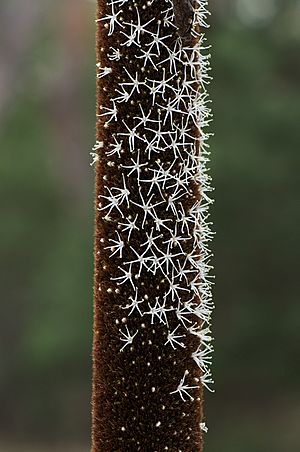Southern grasstree facts for kids
Quick facts for kids Southern grasstree |
|
|---|---|
 |
|
| The tree flowers after a fire in The Grampians, Victoria, Australia | |
| Scientific classification |
The grass tree, also known as Xanthorrhoea australis, is a special plant from Australia. It's the most common type of a group of plants called Xanthorrhoea. These trees can grow very tall, with trunks that sometimes branch out. In some Aboriginal languages, it is called bukkup, baggup or kawee.
Contents
Discovering the Grass Tree
The best way to tell a Xanthorrhoea apart is by looking closely at its leaves. If you cut a leaf of X. australis, its shape would be like a rough diamond. The leaves are also a pretty bluish-green color.
What Does a Grass Tree Look Like?
This plant usually grows a rough trunk. This trunk can be black, often because of bushfires. The trunk can grow more than 3 meters (10 feet) tall. It can also be up to 1 meter (3 feet) wide. Sometimes, the trunk has branches.
The bark of the grass tree is thick and rough. It feels like cork. These trees grow very slowly. It takes many years for a trunk to even start appearing.
The Leaves and Flowers
Long, thin leaves grow in a big bunch at the top of the trunk. When the plant is young, these leaves stand up straight. As they get older, they spread out. The oldest leaves die and hang down. They form a special "skirt" around the trunk.
The blue-green leaves look like needles. They are usually 14 to 30 centimeters (5.5 to 12 inches) long. They also have a waxy coating. These leaves are softer than those of other Xanthorrhoea plants.
Grass trees do not flower every year. They take several years to produce flowers. But after a bushfire, they flower a lot! The flowers grow on a tall, spear-like spike. This spike can reach up to 2 meters (6.6 feet) tall. The flowers have six petals. They usually cover most of the stem. X. australis flowers from July to December. Younger plants might flower in June.
How Long Do Grass Trees Live?
Grass trees can live for a very long time. Some are thought to be between 350 and 450 years old!
Naming the Grass Tree
A botanist named Robert Brown first described this plant in 1810. He wrote about it in his book Prodromus Florae Novae Hollandiae.
The name Xanthorrhoea comes from old Greek words. Xanthos means yellow, and rheo means to flow. This name refers to the yellow resin that comes from these plants. The second part of the name, australis, means "southern." This tells us that the plant is found in the southern parts of Australia.
Where Grass Trees Grow
You can find this plant in many parts of Australia. It grows in New South Wales, the Australian Capital Territory, South Australia, Tasmania, and Victoria. It is the most widespread of all the Xanthorrhoea species.
Grass trees can grow even in poor soils. They don't like too much phosphorus. They can also get sick from a soil disease called Phytophthora cinnamomi.
Uses of the Grass Tree
Indigenous Australians used the grass tree in many ways. They would soak the flowering spikes in water to make a sweet drink. They also ate the soft, white bases of the leaves. Even the growing tip of the stem was a food source.
The flower spike produces a sticky resin. This resin was used as a glue. It helped them make tools. The stem was also used for the bottom part of a spear. People also used the stems to make a base for a fire-drill. This helped them start fires.
Later, the resin was collected and sent to factories. There, it was turned into a shiny coating called lacquer. This lacquer was used to finish furniture.
Images for kids




